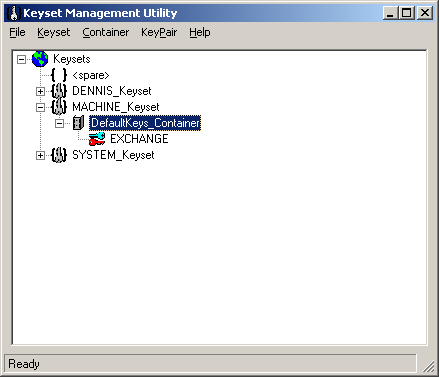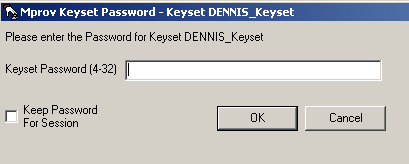Keyset Management Utility
The keyset management utility (gmksm) is designed for the ProtectToolkit-M user, and allows the following operations:
>Create keysets
>Generate key pairs
>Delete key pairs
>Show key pair properties
>Add key containers
>Remove key containers
>Change passwords
This section is intended as a reference for gmksm and outlines the following topics:
>Starting and Exiting the Keyset Management Utility
When performing administrative tasks, the reader is advised to refer to Administrative Tasks for details regarding each task.
Figure 1: Keyset Management Utility User Interface

Starting and Exiting the Keyset Management Utility
To start the keyset management utility, select Start > Programs > SafeNet > ProtectToolkit M > gmksm. After an initial splash screen, the main user interface is shown (seeKeyset Management Utility User Interface).
To exit the utility, select Exit from the File menu.
User Interface
The keyset management utility is presented as a Graphic User Interface (GUI), divided into two main areas. These are:
>The Menu Bar - which is shown along the top of the utility. All available utility commands can be activated via these menus.
>The main display pane - shows all keysets, spare keyset spaces, key containers, and key pairs. These are represented as a hierarchical tree view, with keysets being the highest member. Key containers and key pairs are shown beneath each keyset.
Password Entry Dialogs
Most actions performed within the keyset management utility will require entry of the keyset user password. The keyset password is case-sensitive and may consist of any alphanumeric characters, between 4 and 32 characters in length.
Figure 2: Keyset password entry dialog

Keep Password Feature
The utility can remember the keyset password for the duration of the session. This eliminates the need to repeatedly enter the password for multiple operations.
To enable this feature, check the box next to Keep Password For Session when entering the keyset password.
CAUTION! When this feature is enabled, take care not to leave the utility unattended. To ensure that unauthorized people do not obtain access to a user keyset, close the keyset management utility once you have finished with your task.
Keyboard Shortcuts
All available menu items may be activated via keyboard shortcuts. The menu bar can be selected by pressing the [Alt] key. Commands may then be selected by pressing the first unique letter of the required command. For example: [Alt] followed by [K] will open the Keyset menu.
There are also a number of key combination shortcuts which will immediately activate a command:
>CTRL+A = Add Container
>CTRL+R = Remove Container
>CTRL+K = Create Keyset
>CTRL+P = Change Password
>CTRL+G = Generate Key Pair
>CTRL+D = Delete Key Pair
Context Menus
Right-clicking on an item in the main display pane will bring up a context menu showing available commands specific to that item.
For details about these commands, please refer to the section appropriate to the menu in question.
Container Menu
The Container menu is used to perform the following user actions on a keyset container:
Remove
This option removes the selected key container.
CAUTION! This action destroys any key pairs contained within the selected container.
Generate Key Pair
This option generates a key pair within the selected container. The user is prompted for:
>Key Usage: Select "Sign" or "Exchange".
>Key Size: Valid lengths are 512, 768, 1024, 2048 or 4096 bits.
>Exportable: Checking this box allows the generated private key to be backed up to a file on the host machine.
Key Pair Menu
The Key Pair menu is used to perform the following user actions to a selected key pair:
Delete
This option deletes the selected key pair
Properties
This option displays the properties of the selected key pair. The following attributes are shown:
>Keyset: Displays the name of the keyset where the selected key pair resides.
>Container: Displays the name of the key container where the selected key pair resides.
>Usage: Displays the key usage attribute of the selected key pair. This value will be “EXCHANGE” or “SIGN”.
>Size: Displays the size of the selected key pair.
>Private Key Held: If "TRUE", the private key for the selected key pair is present as part of the key pair. It is only possible to import a public key .
>Exportable: Indicates whether the selected key pair can be backed up.
